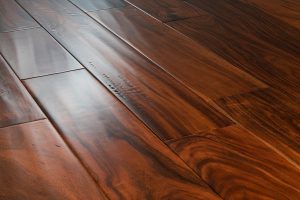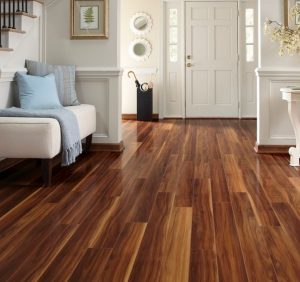The Pros and Cons of Floating Wood Floors in Basements
Most would agree that hardwood flooring would be one of the more preferred floor covering options for basements. Recent studies in residential remodeling support this trend. The look of hardwood has a traditional look of luxury and beauty that offers a long lasting classic floor treatment.
For basement applications, traditional “nail down” hardwood is not practical because of the concrete floor. Traditional nail down flooring would require the additional expense of constructing a built-up wood sub floor before the hardwood installation. This approach does add considerable expense and results in the loss of 2 1/2” of ceiling height clearance which can be significant in some basements.
Engineered hardwood and laminated options, however, offer homeowners with several options to achieve the look of hardwood. There is some confusion, however, between engineered wood and laminate flooring. Often, both products are mistaken as one and the same thing, but this could not be more off base. While both have their pros and cons as flooring treatments, comparing them is like comparing apples and oranges. The engineered hardwood products are made of multiple inner layers of plywood, high density fiber, or hardwood. The outer most layer is a thin (1/8”) layer of hardwood veneer of the species of wood selected, i.e. oak, pine, cherry, etc. Laminate flooring has a core of high density fiberboard and its surface is pretty much a picture of wood, digitally rendered to imitate the look of wood flooring.

For comparison purposes, here are some of the Pros and Cons for Engineered vs Laminate flooring one should consider.
Engineered Flooring:
Pro:
- More stable than traditional hardwood
- Can be installed as glue down or floating
- More eco-friendly than traditional wood
- Can be installed over concrete
- Will not swell or warp
- Relatively low maintenance
- Top veneer is real wood
- Can be installed over radiant heat
- Life expectancy up to 75 years; can be sanded and refinished perhaps once or twice.
Con:
- Almost as expensive as traditional hardwood: $9- 13/s.f.
- Difficult to repair, especially if installed as glue down
Laminate
Pro:
- Installed floating
- More eco-friendly than traditional wood
- Can be installed over concrete
- Relatively low maintenance
- Can be installed over radiant heat
- Less expensive than engineered and traditional hardwood; $5-$9/s.f.
- Stain resistant
- Resists fading like real wood
Con:
- Life expectancy around 20 years and then needs replacement
- Cannot be sanded or refinished.
- Can be slippery when wearing socks and for pets
- Not real wood
As you consider the type of floor treatment that will be installed in your basement or recreation room, you can add engineered flooring and laminate to the list of options along with carpet, vinyl, and ceramic tile. No flooring is perfect. If you prefer the look of real hardwood in you basement, laminate floor and engineered flooring offer excellent options. Just be prepared to understand some of the little issues that go along with the benefits.

